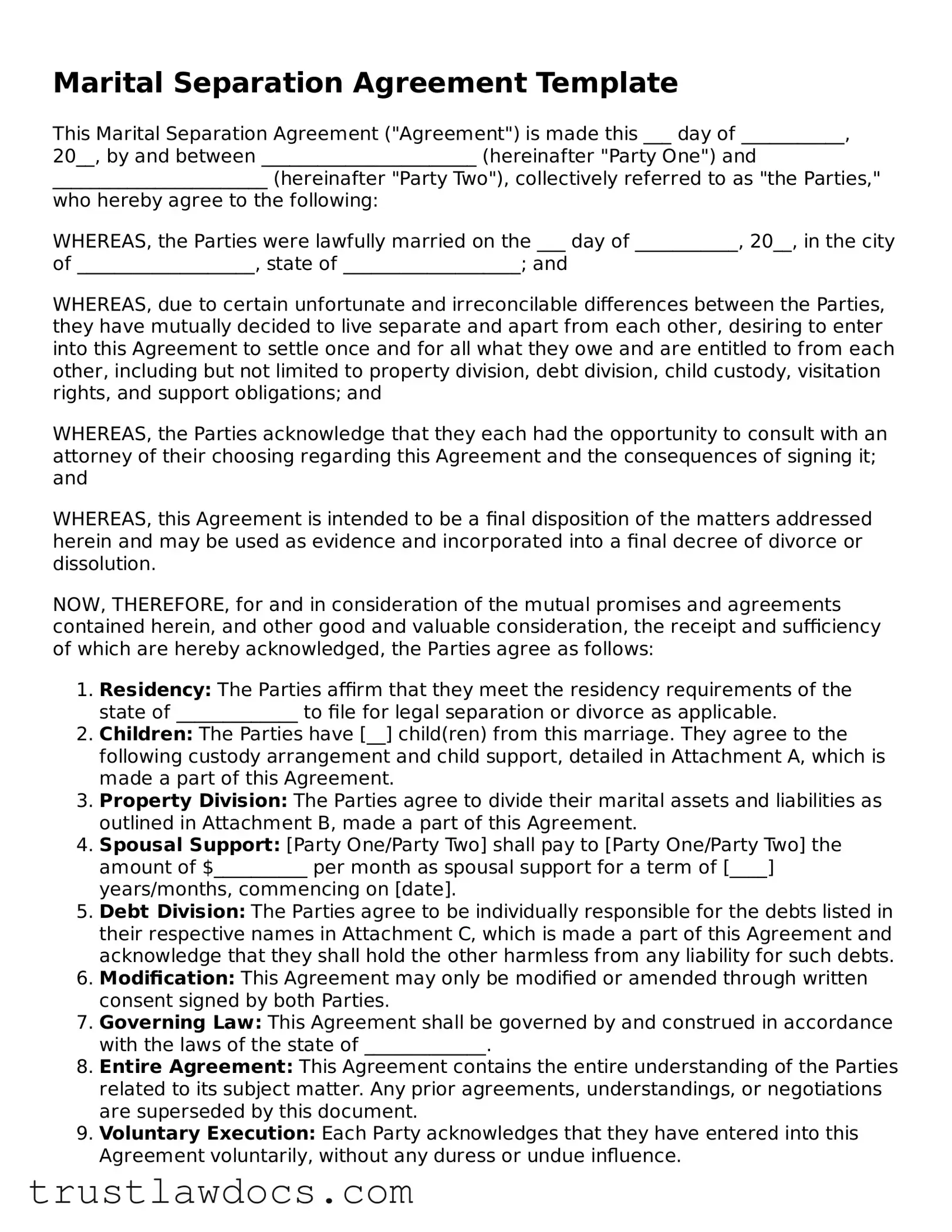Marital Separation Agreement Template
This Marital Separation Agreement ("Agreement") is made this ___ day of ___________, 20__, by and between _______________________ (hereinafter "Party One") and _______________________ (hereinafter "Party Two"), collectively referred to as "the Parties," who hereby agree to the following:
WHEREAS, the Parties were lawfully married on the ___ day of ___________, 20__, in the city of ___________________, state of ___________________; and
WHEREAS, due to certain unfortunate and irreconcilable differences between the Parties, they have mutually decided to live separate and apart from each other, desiring to enter into this Agreement to settle once and for all what they owe and are entitled to from each other, including but not limited to property division, debt division, child custody, visitation rights, and support obligations; and
WHEREAS, the Parties acknowledge that they each had the opportunity to consult with an attorney of their choosing regarding this Agreement and the consequences of signing it; and
WHEREAS, this Agreement is intended to be a final disposition of the matters addressed herein and may be used as evidence and incorporated into a final decree of divorce or dissolution.
NOW, THEREFORE, for and in consideration of the mutual promises and agreements contained herein, and other good and valuable consideration, the receipt and sufficiency of which are hereby acknowledged, the Parties agree as follows:
- Residency: The Parties affirm that they meet the residency requirements of the state of _____________ to file for legal separation or divorce as applicable.
- Children: The Parties have [__] child(ren) from this marriage. They agree to the following custody arrangement and child support, detailed in Attachment A, which is made a part of this Agreement.
- Property Division: The Parties agree to divide their marital assets and liabilities as outlined in Attachment B, made a part of this Agreement.
- Spousal Support: [Party One/Party Two] shall pay to [Party One/Party Two] the amount of $__________ per month as spousal support for a term of [____] years/months, commencing on [date].
- Debt Division: The Parties agree to be individually responsible for the debts listed in their respective names in Attachment C, which is made a part of this Agreement and acknowledge that they shall hold the other harmless from any liability for such debts.
- Modification: This Agreement may only be modified or amended through written consent signed by both Parties.
- Governing Law: This Agreement shall be governed by and construed in accordance with the laws of the state of _____________.
- Entire Agreement: This Agreement contains the entire understanding of the Parties related to its subject matter. Any prior agreements, understandings, or negotiations are superseded by this document.
- Voluntary Execution: Each Party acknowledges that they have entered into this Agreement voluntarily, without any duress or undue influence.
- Legal Representation: The Parties acknowledge the right to have been advised by legal counsel of their own choosing and affirm that they understand fully the terms and their implications set forth in this Agreement.
IN WITNESS WHEREOF, the Parties have executed this Marital Separation Agreement on the date first above written.
_____________________________
Party One Signature
_____________________________
Party Two Signature
Notary Public: _____________________
Date: _______________
State of ________________
County of ______________
This document was acknowledged before me on ______________ (date) by ___________________ (name(s) of signatory(ies)).
My commission expires: _______________
___________________________
Signature of Notary Public
Seal:
